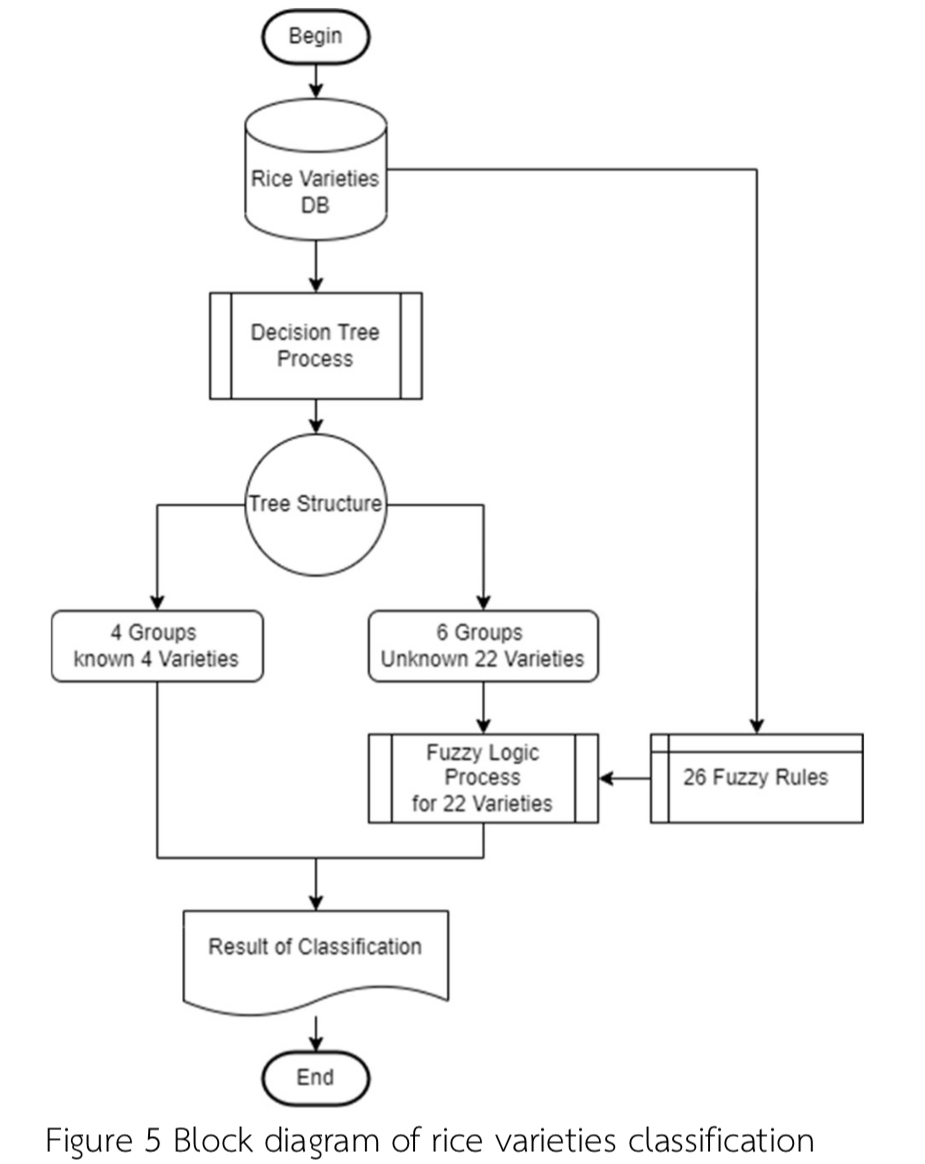Rice Variety Identification Using Morphological Characteristics of Paddy Seed via Decision Tree and Fuzzy Logic
Main Article Content
บทคัดย่อ
The collection of various rice varieties is a way of rice seed conservation. The conservation of rice varieties solves the problem of shortage of pure and good quality rice seeds as well as helps to conserve rice varieties from being lost. Moreover, the selected rice varieties can be used as good breeders for future breeding. The morphological characteristics of rice varieties were used as the components for rice variety identification. Therefore, rice specialists and tools are an important role in rice variety identification. The aim of the study was to present the idea of using computers to build an artificial intelligence method for rice variety identification. The fuzzy logic and decision tree techniques were used to perform the proposed system for problem-solving rice variety identification. The morphological analysis of paddy seed is composed of two steps. In the first step, the decision tree technique was applied to filter the quality data of the paddy seed morphology. Subsequently, the other quantitative data of the paddy seed morphology were processed with fuzzy logic techniques to identify the rice varieties. A total of twenty-six rice varieties were used in the experiment as the proposed method and twelve characteristics of paddy seed morphological data were evaluated to identify rice varieties. The results summarized that the computer system and artificial intelligence technique in the proposed method successfully identified rice variety identification. The eighteen rice varieties of twenty-six rice varieties demonstrated a proportion of true prediction of more than 70% from a total prediction.
Article Details

อนุญาตภายใต้เงื่อนไข Creative Commons Attribution-NonCommercial-NoDerivatives 4.0 International License.
สมาคมวิศวกรรมเกษตรแห่งประเทศไทย
Thai Socities of Agricultural Engineering
เอกสารอ้างอิง
กองวิจัยและพัฒนาข้าว กรมการข้าว. 2559. คุณภาพข้าว. แหล่งข้อมูล: http://webold.ricethailand.go.th/rkb3/ title-index.php-file=content.php&id=6-2.htm. เข้าถึงเมื่อ 9 ตุลาคม 2562.
ธีระ ธรรมวงศา, จิรวัฒน์ สนทิชน, อมรรัตน์ มีสวาสดิ์, และ ปิยะรัตน์ อิฐรัตน์ 2555. ลักษณะทางสัณฐานวทิยาและกายวิภาคศาสตร์ของข้าวเปลือกข้าวดํานาสวน ในภาคตะวันออกเฉียงเหนือของประเทศไทย, วารสารวิทยาศาสตร์ มข. ฉบับที่ 40. หน้า 1138-1148.
สุรีย์ ศรีวันทนียกุล, สรรเสริญ ศรีสุนทร, ศิริชัย สมบูรณ์พงษ์, เล็ก จันทร์เกษม, สมบัติ รุจาคม และ อรพิน วัฒเนสก์. 2539. การรวบรวม อนุรักษ์ ประเมิน ลักษณะและจัดหมวดหมู่ข้าวพื้นเมืองในเขตศูนย์วิจัย ข้าวพิษณุโลก. ศูนย์วิจัยข้าวพิษณุโลก สถาบันวิจัย ข้าว กรมวิชาการเกษตร กระทรวงเกษตรและ สหกรณ์. 215 หน้า.
OuYang, A.G., Gao, R. J., Liu, Y. D., Sun, X. D., Pan, Y. Y., and Xiao-ling Dong. 2010. An automatic method for identifying different variety of rice seeds using machine vision technology. 2010 Sixth International Conference on Natural Computation. pp. 84-88.
Appa, R.S., Bounphanousoy, C., Kanyavong, K., Phetpaseuth, V., Sengthong, B., Schiller, J.M., Thirasack, S., and Jackson, M.T. 1997. Collection and Classification of Rice Germplasm from the Lao PDR. Part 2: Northern, Southern and Central Regions, LaoIRRI Project. (pp. 41). Vientiane: National Agricultural Research Center, Lao PDR.
Mahmoud, O. 2011. Design of an expert system for sorting pistachio nuts through decision tree and fuzzy logic classifier. Expert Systems with Applications. 38(4), 4339-4347.
Safavian, S. R., and Landgrebe, D. 1991. A survey of decision tree classifier methodology. IEEE Transactions on Systems, Man, and Cybernetics. 21(3), 660-674.


